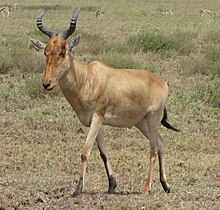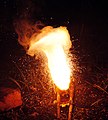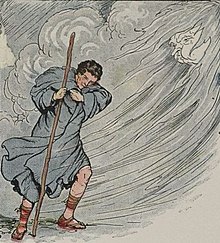Portal:Science
Science portal

Science is a strict systematic discipline that builds and organizes knowledge in the form of testable hypotheses and predictions about the world. Modern science is typically divided into three major branches: the natural sciences (e.g., physics, chemistry, and biology), which study the physical world; the social sciences (e.g., economics, psychology, and sociology), which study individuals and societies; and the formal sciences (e.g., logic, mathematics, and theoretical computer science), which study formal systems, governed by axioms and rules. There is disagreement whether the formal sciences are scientific disciplines, as they do not rely on empirical evidence. Applied sciences are disciplines that use scientific knowledge for practical purposes, such as in engineering and medicine. (Full article...)
Featured article -
Podokesaurus is a genus of coelophysoid dinosaur that lived in what is now the eastern United States during the Early Jurassic Period. The first fossil was discovered by the geologist Mignon Talbot near Mount Holyoke, Massachusetts, in 1910. The specimen was fragmentary, preserving much of the body, limbs, and tail. In 1911, Talbot described and named the new genus and species Podokesaurus holyokensis based on it. The full name can be translated as "swift-footed lizard of Holyoke". This discovery made Talbot the first woman to find and describe a non-bird dinosaur. The holotype fossil was recognized as significant and was studied by other researchers, but was lost when the building it was kept in burned down in 1917; no unequivocal Podokesaurus specimens have since been discovered. It was made state dinosaur of Massachusetts in 2022. (Full article...)
A virus is a submicroscopic infectious agent that replicates only inside the living cells of an organism. Viruses infect all life forms, from animals and plants to microorganisms, including bacteria and archaea. Viruses are found in almost every ecosystem on Earth and are the most numerous type of biological entity. Since Dmitri Ivanovsky's 1892 article describing a non-bacterial pathogen infecting tobacco plants and the discovery of the tobacco mosaic virus by Martinus Beijerinck in 1898, more than 11,000 of the millions of virus species have been described in detail. The study of viruses is known as virology, a subspeciality of microbiology. (Full article...)
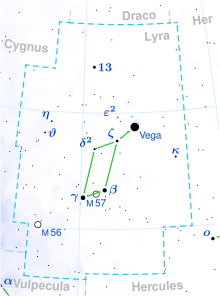
Vega is the brightest star in the northern constellation of Lyra. It has the Bayer designation α Lyrae, which is Latinised to Alpha Lyrae and abbreviated Alpha Lyr or α Lyr. This star is relatively close at only 25 light-years (7.7 parsecs) from the Sun, and one of the most luminous stars in the Sun's neighborhood. It is the fifth-brightest star in the night sky, and the second-brightest star in the northern celestial hemisphere, after Arcturus. (Full article...)
The hartebeest (/ˈhɑːrtəˌbiːst/; Alcelaphus buselaphus), also known as kongoni or kaama, is an African antelope. It is the only member of the genus Alcelaphus. Eight subspecies have been described, including two sometimes considered to be independent species. A large antelope, the hartebeest stands just over 1 m (3 ft 3 in) at the shoulder, and has a typical head-and-body length of 200 to 250 cm (79 to 98 in). The weight ranges from 100 to 200 kg (220 to 440 lb). It has a particularly elongated forehead and oddly-shaped horns, a short neck, and pointed ears. Its legs, which often have black markings, are unusually long. The coat is generally short and shiny. Coat colour varies by the subspecies, from the sandy brown of the western hartebeest to the chocolate brown of the Swayne's hartebeest. Both sexes of all subspecies have horns, with those of females being more slender. Horns can reach lengths of 45–70 cm (18–28 in). Apart from its long face, the large chest and the sharply sloping back differentiate the hartebeest from other antelopes. A conspicuous hump over the shoulders is due to the long dorsal processes of the vertebrae in this region. (Full article...)

The Olympic marmot (Marmota olympus) is a rodent in the squirrel family, Sciuridae; it occurs only in the U.S. state of Washington, on the middle elevations of the Olympic Peninsula. The closest relatives of this species are the hoary marmot and the Vancouver Island marmot. In 2009, it was declared the official endemic mammal of Washington. (Full article...)
Featured pictures
Vital articles

Did you know...
- ... that the calling patterns of the Japanese tree frog have been used in wireless network design, furthering an area of science known as swarm intelligence?
- ... that according to science fiction essayist Jacques Van Herp, the novella The End of Illa caused the temporary decline of French science fiction?
- ... that the 14th-century house Maison de Jeanne was positively dated with the science of dendrochronology?
- ... that the concept of hyperspace, primarily known through its use in science fiction, originated from and is still occasionally used in scholarly works?
- ... that the Data Colada bloggers drew attention to the replication crisis by exposing faulty social science research?
- ... that E. F. Bleiler conducted research for Science-Fiction: The Gernsback Years by reading all 1,835 stories published in science fiction magazines between 1926 and 1936?
Get involved
| This portal needs to be updated. Please help update this portal to reflect recent events or newly available information. Relevant discussion may be found on the talk page. |

|
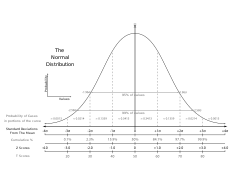
|
Science News
- 24 July 2024 –
- Researchers from the Scottish Association for Marine Science report evidence of dark oxygen being produced from metals on the seafloor. It was previously assumed that almost all the free oxygen (O
2) on Earth was created through photosynthesis, which requires sunlight. (NPR) - 23 July 2024 –
- A study by the Oswaldo Cruz Foundation finds thirteen Brazilian sharpnose sharks off the coast of Brazil with high levels of cocaine in their muscles and livers. Experts believe that the cocaine is making its way into the waters via illegal labs where the drug is manufactured or through the excrement of drug users. (BBC News)
- 15 July 2024 – Mare Tranquillitatis pit
- In the journal Nature Astronomy, American and Italian scientists announce the discovery of a lunar cave, approximately 250 miles (400 km) from the landing site of Apollo 11. (AP) (Nature Astronomy)
- 10 July 2024 –
- Researchers from Northwestern University Feinberg School of Medicine and Harvard Medical School publish a claim for the cause and curative path for the autoimmune disease systemic lupus erythematosus in the journal Nature. (Newsmax) (Nature)
- 3 July 2024 –
- Scientists announce the discovery of the world's oldest cave painting, depicting three people gathered around a large red pig, estimated to be at least 51,200 years old, in Leang Karampurang cave in the Maros-Pangkep region, South Sulawesi, Indonesia. (Al Jazeera)
- 20 June 2024 – 2024 in archosaur paleontology
- Researchers announce the discovery the Lokiceratops rangiformis, a dinosaur species named after the Norse god Loki, in North America. The findings are published in the journal PeerJ. (ABC News)











